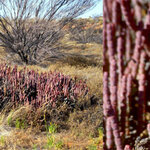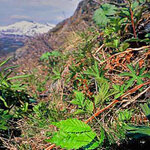Ecology & Zoology

Ecosystems are constantly exchanging materials through the movement of air in the atmosphere, the flow of water in rivers and the migration of animals across the landscape. People, however, have also established themselves as another major driver of connectivity among ecosystems.
In the June 2008 Special Issue of Frontiers in Ecology and the Environment, titled “Continental-scale ecology in an increasingly connected world,” ecologists discuss how human influences interact with natural processes to influence connectivity at the continental scale. The authors conclude that networks of large-…

Nautiloids are the sole surviving family of externally-shelled cephalopods that thrived in the tropical oceans 450–150 million years ago. However, in the intervening years their modern soft bodied relatives dumped the shell and developed complex central nervous systems; which makes Nautilus ideally suited to discover the ‘evolutionary pathways that led to the development of the complex coleoid [soft bodied cephalopod] brains’ say Robyn Crook and Jennifer Basil.
Knowing that the simple Nautilus brain lacks the structures required for memory in more sophisticated cephalopods, Crook and Basil…

Nitrogen is the primary nutrient that dictates productivity (and thus carbon consumption) in boreal forests. In pristine boreal ecosystems, most new nitrogen enters the forest through cyanobacteria living on the shoots of feather mosses, which grows in dense cushions on the forest floor.
These bacteria convert nitrogen from the atmosphere to a form that can be used by other living organisms, a process referred to as "nitrogen-fixation." The researchers showed that this natural fertilization process appears to be partially controlled by trees and shrubs that sit above the feather mosses.
In…

Throughout the overlooked depths of Lake Michigan and other Great Lakes, a small but important animal is rapidly disappearing.
Until recently, the animal - a shrimplike, energy-dense creature called Diporeia - was a major food source for commercially important species like lake whitefish and many prey fish upon which salmon, trout and walleye rely.
Scientists are employing new research methods in a quest to explain their population freefall, which threatens to negatively affect the Lakes' ecosystems and $4 billion sport fishing industry, said Purdue University researcher Marisol Sepúlveda.…

People love Top 10 lists and a Top 10 list of new species is no exception. We love the idea so much we took the 2007 choices from the International Institute for Species Exploration at Arizona State University and an international committee of taxonomists and made them ... funnier.
We know you have other things to read, like a Top 10 list of String Theory jokes, somewhere so we'll get right to it.
10. Tecticornia bibenda. One of two on this list that seems to have made it for no other reason than that press releases gave it a catchy nickname, in this case the "Michelin Man™" plant, and…

Sweden's mountains are growing greener. At the border between woods and bare mountain, trees that require warm temperatures, such as oak, elm, maple, and black alder, have become established for the first time in 8,000 years. This is shown in current studies led by Leif Kullman, professor of physical geography at Umeå University in Sweden.
Over the last century, the temperature has risen by more than one degree. The cooling trend over several thousand years is broken, and this has triggered changes in flora, fauna, and landscapes. In important respects, the present state is similar to what…

Do you like that title? I can't help it, I hear that song from Robin Hood every time I see the word 'oekologie' so hum along with me and enjoy episode #16.
First, I can't take credit for finding most of the terrific stuff contained in here. We're big fans of community events like this so we bothered everyone we could to help find good stuff rather than stay passive and just use submissions that got sent in. As a result, we got some terrific work that was done over the last month. Let's get right to it.
Justin at Sustainablog advocates a velvet glove approach rather than the iron fist…

This is the first in a series of posts in which I plan to examine one of the fundamental concepts in ecology - the species-area relationship
Species conservation has always been intimately linked with the idea of habitat conservation. While habitat quality determines the amount of habitat required to protect a viable population of a given species, it’s only a modifier - the determining factor is area. Habitat quality can determine whether you need more or less area, but area is still the critical factor. While protected areas can be set aside for specific species, more commonly protected…

Mice and humans have genomes that are 85% identical, making them suitable and cost-effective stand-ins for humans in medical research. A recent article by University of Michigan evolutionary biologists Ben-Yang Liao and Jianzhi Zhang discussed how identical genes may behave differently in mice and men - and some essential to humans aren't missed at all by mice.
"Everyone assumes that deletion of the same gene in the mouse and in humans produces the same phenotype (an observable trait such as presence or absence of a particular disease). That's the basis of using the mouse to study human…

Most female frogs don’t call; most lack or have only rudimentary vocal cords. A typical female selects a mate from a chorus of males and then –silently – signals her beau. But the female concave-eared torrent frog, Odorrana tormota, has a more direct method of declaring her interest:
She emits a high-pitched chirp that to the human ear sounds like that of a bird.
O. tormota lives in a noisy environment on the brushy edge of streams in the Huangshan Hot Springs, in central China, where waterfalls and rushing water provide a steady din. The frog has a recessed eardrum, said Albert Feng, a…